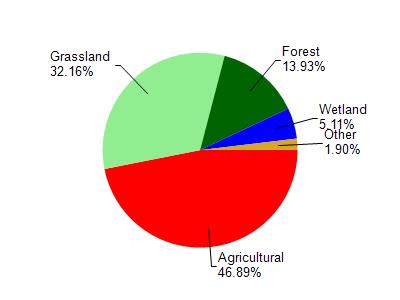Green
No
No
No
Fish and Aquatic Life
Overview
, in the Little Sugar River Watershed, is a 10.29 acre lake that falls in Green County. This lake is managed for fishing and swimming and is currently not considered impaired.
Date 2011
Author Aquatic Biologist
Historical Description
Source:1980, Surface Water Resources of Green County,WI:WI-DNR Lake Montesian, T3N, R8E, S7 Surface Acres = 7.0, S.D.F. = 2.16, Maximum Depth = 15 feet This small man-made lake lies entirely within a park on the west side of Monticello. In 1966, the Village completed lake construction at an old mill pond site. It is triangular with an island in the center, accessible by a foot bridge. Springs and an artesian well feed the lake and an overflow runs to the West Branch of the Little Sugar River. The water is very clear in spite of a muck bottom. Aquatic vegetation includes pondweeds, coontail, bulrush, cattail and sedges. Lake Montesian was chemically treated with rotenone in the spring of 1974 to remove a stunted panfish population. It was subsequently restocked with largemouth bass. Northern pike, white suckers and bluegills are also found in the lake. Waterfowl on Lake Montesian include mallards, coots and occasionally Canada geese. Fishing and nonmotorized boating are allowed on the lake and the park provides picnic facilities including a shelter. Fish Species: Largemouth bass, northern pike, white sucker, bluegill.
Date 1980
Author Surface Water Inventory Of Wisconsin
Condition
Wisconsin has over 84,000 miles of streams, 15,000 lakes and milllions of acres of wetlands. Assessing the condition of this vast amount of water is challenging. The state's water monitoring program uses a media-based, cross-program approach to analyze water condition. An updated monitoring strategy (2015-2020) is now available. Compliance with Clean Water Act fishable, swimmable standards are located in the Executive Summary of Water Condition in 2018. See also the 'monitoring and projects' tab.
Reports
Management Goals
Wisconsin's Water Quality Standards provide qualitative and quantitative goals for waters that are protective of Fishable, Swimmable conditions [Learn more]. Waters that do not meet water quality standards are considered impaired and restoration actions are planned and carried out until the water is once again fishable and swimmable
Management goals can include creation or implementation of a Total Maximum Daily Load analysis, a Nine Key Element Plan, or other restoration work, education and outreach and more. If specific recommendations exist for this water, they will be displayed below online.
Monitoring
Monitoring the condition of a river, stream, or lake includes gathering physical, chemical, biological, and habitat data. Comprehensive studies often gather all these parameters in great detail, while lighter assessment events will involve sampling physical, chemical and biological data such as macroinvertebrates. Aquatic macroinvertebrates and fish communities integrate watershed or catchment condition, providing great insight into overall ecosystem health. Chemical and habitat parameters tell researchers more about human induced problems including contaminated runoff, point source dischargers, or habitat issues that foster or limit the potential of aquatic communities to thrive in a given area. Wisconsin's Water Monitoring Strategy was recenty updated.
Grants and Management Projects
Monitoring Projects
| WBIC | Official Waterbody Name | Station ID | Station Name | Earliest Fieldwork Date | Latest Fieldwork Date | View Station | View Data |
|---|
| 881600 | Lake Montesian | 10002696 | Lake Montesian | 7/27/1999 | 8/23/2022 | Map | Data |
| 881600 | Lake Montesian | 10043666 | Lake Montesian Fishing Area | 8/7/2014 | 8/7/2014 | Map | Data |
|

Watershed Characteristics
Lake Montesian is located in the Little Sugar River watershed which is 133.02 mi². Land use in the watershed is primarily agricultural (46.80%), grassland (32.10%) and a mix of forest (13.90%) and other uses (7.00%). This watershed has 351.74 stream miles, 50.40 lake acres and 3,252.10 wetland acres.
Nonpoint Source Characteristics
This watershed is ranked Not Ranked for runoff impacts on streams, Not Ranked for runoff impacts on lakes and High for runoff impacts on groundwater and therefore has an overall rank of High. This value can be used in ranking the watershed or individual waterbodies for grant funding under state and county programs.However, all waters are affected by diffuse pollutant sources regardless of initial water quality. Applications for specific runoff projects under state or county grant programs may be pursued. For more information, go to surface water program grants.